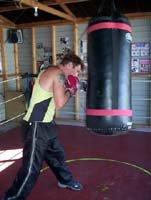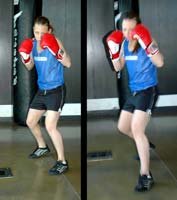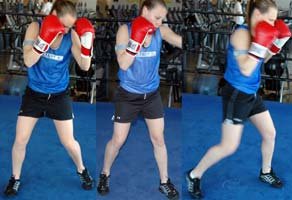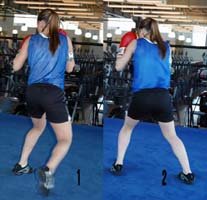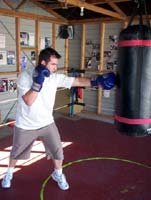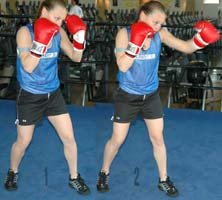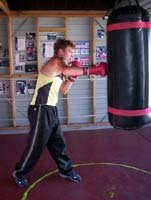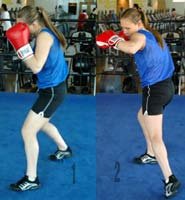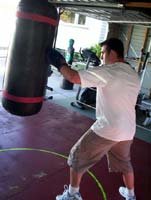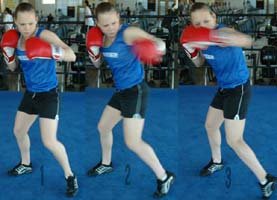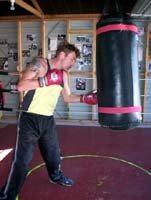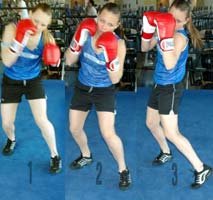In the 21st century, professional boxing attracts major sponsorship deals and makes fighters millionaires. Amateur boxing is also growing exponentially. Those looking for a challenge are attracted by the allure of the benefits to be realized. Indeed, boxing is increasing in popularity almost daily, with movies like "Million Dollar Baby" and massive pay-per-view events attracting millions of viewers.
Boxing has become a global phenomenon with tremendous cross-over appeal. The fitness industry has latched on to the boxing popularity with box-out classes and the like. Why has boxing become immensely popular and how does one become proficient at its practice? The following article will shed some light.
 Why Box?
Why Box? 
Boxing provides many benefits and challenges. For example, it has the potential to turn lives around by providing focus and an outlet for pent up aggression. Boxing's greatest benefit might be in the training and preparation needed to reach the fighting level. Indeed, the actual fighting aspect need not be emphasized to realize boxing's many benefits, which include:
 1: The Ultimate Workout
1: The Ultimate Workout

-
The typical boxing training session stimulates all muscle groups, and provides the perfect combination of aerobic (with oxygen) and anaerobic (short-burst, without oxygen) exercise. Indeed, the boxers' workout is guaranteed to get anyone into the best shape of their lives.
To perfect the basic boxing skills while developing the stamina to survive three, 3-minute rounds of sparring (actual fighting in a controlled gym-setting to prepare for the real thing), one needs to be supremely conditioned and strong enough to throw powerful punches from Round 1 through Round 3.
The boxing workout improves every type of physical capacity: strength, power, coordination, aerobic fitness, anaerobic fitness and endurance. Exercises that are emphasized include, heavy bag, speed-ball spring-ball and medicine-ball work, skipping, running, weight-training (calisthenics mainly) and wind-sprints.
 |
||||
 |
|
 |
||
 |
||||
-
Exercises are shortened and combined to form a circuit or performed independently over a longer period. In short, boxing improves reflexes, endurance, flexibility, coordination, speed, power and cardiovascular fitness.
- Warm-up: 5 minutes on exercise bike followed by stretching of all major muscle groups.
- Sit-ups with medicine ball: three sets of 25.
- Skipping five sets of two-minutes.
- Five two-minute rounds on heavy bag.
- Three two-minute rounds on the speed-ball.
- Side laterals: three sets of 15.
- Bike: five minutes to cool down.
A sample boxing workout (about one-hour).
Note: All exercises have a 1-minute rest between rounds as per the period given between rounds in an actual boxing match.
 2: Confidence
2: Confidence
-
Possessing the skills to look after yourself gives you a significant amount of confidence. Contrary to popular belief, boxers typically do not seek confrontation. Their skills and confidence convey an inward belief that there is nothing to prove. If you have nothing to prove, you will be less compelled to prove it.
However, if boxers needs to protect themselves in a self-defense situation, they will be more adept at finishing things quickly and cleanly, due to heightened confidence levels and skill.
When someone is confident in the ability to defend themselves physically, this often translates to a psychological benefit of self-contentment and peace of mind.
 3: Stress Relief
3: Stress Relief
-
Boxing is the ultimate sport for countering stress, in my view. The combination of
strength training and
aerobic work provides the best of both worlds in terms of feeling a muscular pump and stimulating the cardiovascular system - both of which enhance
psychological well-being.
After a hard day, hitting the heavy bag for 5-to-6 rounds serves as a tremendous stress release. Boxing (particularly concentrating on the focus mitts) enhances the ability to relax, which helps keep the boxer calm and poised under pressure. In this sense, boxing might help one to manage their life more efficiently.
 4: Providing The Ultimate Contest Between Two People
4: Providing The Ultimate Contest Between Two People
-
Boxing allows for a direct competitive experience between to people in a controlled setting. Depending on the athletes's disposition, this can be a great self-esteem boost.
Full-contact sparring, which is optional in many boxing classes, provides the perfect platform to refine fundamental boxing skills, and a great test of physical capability and courage.
 Equipment Needed
Equipment Needed 
Before engaging in any form of boxing training, the right equipment must be available for both safety and performance reasons.

- Gloves (bag and sparring): bag gloves are smaller and designed for speed of movement to enhance the refinement of skills. Sparring gloves are larger with greater degree of padding to protect ones opponent from serious damage.
- Wraps: absolutely essential for hand support and protection. Wraps hold the bones of the hand together while lessening excessive impact to the hand and wrist.
- Mouth guard: required for sparring to prevent damage to the teeth, cuts to the mouth and to protect the jaw. Clamping down on a mouth-guard will immobilize the jaw to prevent damage stemming from impact.
- Speed-ball: an inflated ball hanging from a back-board. The speed ball acts as a rhythm bag, to develop hand/eye coordination - the same sort of coordination used in a blocking punch (when glove is used to push away the opponent's punch). Hit the ball with side of hand or knuckles.
- Heavy bag: the heavy bag is the most used piece of boxing training equipment. It allows one to develop all of the main boxing punches, while enhancing punching power. Practice combinations and single punches on the heavy bag.
 |
||||
 |
|
 |
||
 |
||||
- Double-end bag: an inflated ball situated between two ropes or cords (one attached to the ceiling, one to the floor) and used to develop hand/eye coordination and balance. This bag also provides a moving target, which enhances timing (the ability to pick punches and land combinations at exactly the right moment).
- Skipping rope: jumping rope (at various speeds and using different techniques) will improve footwork, enhance stamina and build shoulder strength, making it a fundamental boxing requirement. Bounce lightly on the balls of the feet and vary the foot spacing and angles.
- Medicine ball: an inflated ball which varies in weight. Used to perform a multitude of movements. The main benefit to using the medicine ball is its versatility. It can be used anywhere at anytime and entire work-outs can be designed around it. The medicine ball causes one to train in an unstable environment, which improves balance and coordination.
- Focus mitts: a trainer uses focus mitts (placed on their hands) for the trainee to hit. These are important for skill development, balance and timing. The trainer will call for a punch, or a combination of punches, while the trainee focuses on perfecting their technique.
 How To Box
How To Box 
 Stance & Footwork
Stance & Footwork
- Stand with the feet hip-width apart.
- Take a single, regular, striding step forward with the left foot.
- Back foot kept at a 45-degree angle.
- Shift weight onto the balls of the feet.
- Distribute weight equally between the feet.
- Keep the knees bent.
- Bend elbows and tuck them into the sides (to protect the vital organs). As arms are brought into sides, place fists at cheekbone level, with left hand slightly out, poised to jab.
- Keep chin down and look up.
- Roll shoulders forward slightly.
- Position body partially sideways with left shoulder and hand slightly closer opponent.
Stance in boxing is vitally important as it sets the platform for all basic punches.
The main stance in boxing is the common orthodox stance, which is used when sparring or engaging in bag work. To get into this stance do the following:
Note: those who naturally lead (jab) with their right hand are called southpaw fighters. To change to southpaw place right foot forward and turn body slightly to the left.
Footwork is equally essential. Punches directed at one's opponent will not land if one cannot efficiently get close enough. Similarly, evading the opponents punches will be all the harder if footwork is lacking.
The key with footwork is to ensure the body is centered and balanced at all times and that fighting stance is maintained. With footwork, the focus should be on moving backward and forward, lateral movement (moving left and right) and pivoting.
 Moving Backward & Forward
Moving Backward & Forward
-
When moving forward, push off the back foot and step forward with front foot half a step. Follow front foot with back foot in a shuffling motion to arrive back at the fighting stance.
Move backward only when absolutely necessary and try to fire punches while retiring. To move backward, push off with the ball of the front foot, while stepping back with back foot one half step. Follow with front foot, back to fighting stance.
 Lateral movement
Lateral movement
-
Lateral movement involves moving/pushing either left or right to evade ones opponent. To move left, push off from the ball of right foot while left foot moves one half step to the left.
Follow with the right foot to achieve correct fighting stance. To move right, push off from the ball of left foot while moving right foot one half step to the right. Follow with left foot.
 Pivoting
Pivoting
-
Pivoting enables one to quickly change the angle of approach to effectively counterpunch their opponent. Begin by shifting weight to the ball of the front foot; then push off with the back foot to pivot the front foot a quarter turn to the left or right. This should throw opponent off balance and open them up to attack.
 Basic punches
Basic punches
-
Before even contemplating sparing, four basic punches need to be mastered: the left jab, right cross, left hook and left uppercut. These punches are designed for the orthodox stance fighter.
The southpaw will simply perform these punches with the opposite hands, leading with the right jab. These punches are the bread and butter of boxing and, once mastered, can be put into combinations and used in a sparing context. Remember, in order to successfully learn the following punches, stance and footwork need to be perfect.
- Stand in boxing stance holding fists in a palms in ready position.
- Throw punch in a direct line straight from the chin.
- Once hand leaves the guard position (from chin), rotate fist half and inch.
- Keep fist relaxed throughout this movement, until just before the point of contact when it is fully clenched.
- Immediately relax fist and bring back to guard position.
- Stand in fighting stance and throw right hand directly from the chin guard position.
- While throwing cross, turn torso into punch and pivot on right foot (ensure the whole of the upper body is thrown into punch to generate power).
- As right heel pivots outward, accelerate punch toward opponent.
- Again, relax hand throughout movement, until the point of contact, when hand should be clenched tight.
- From orthodox stance, transfer weight to the left side.
- From guard position, left elbow is bought up so it is almost parallel with the floor (arm should form a hook shape at this stage).
- At this time, the fist is rotated and a punch is thrown.
- When a punch is thrown, pivot left foot, left leg and torso sharply to the right to generate the force.
- From guard position, dip left so elbow rests near the left hip.
- Rotate fist palm upward.
- Launch punch with the left side of body.
 Left Jab
Left Jab
-
The most used punch in boxing is the left jab, making it the most important to master. The jab is used primarily to keep ones opponent a distance; to set them up for one of the power shots: for example, the right-cross.
Although the jab is not considered a power punch, it can cause considerable damage over the course of a fight.
To Perform The Jab
 Right (or straight) Cross
Right (or straight) Cross
-
The right cross is often referred to as the most enjoyable punch to throw. It is thrown with the right hand - a natural movement for most. A large degree of power can be transferred through the right cross - it is most often responsible for many of the knockouts seen in a boxing match.
The right cross should be utilized behind the jab, as a knockout punch, rather than being used too often, which can lead to overbalancing (boxers put themselves slightly off balance when the right is thrown) and exposure to a counterpunch.
To Perform This Punch
 Left Hook
Left Hook
-
The left hook is typically the hardest punch to master. It is thrown at an unnatural angle and requires a great deal more motor coordination.
The hook works best when fighting on the inside (very close to the opponent).
It is devastating punch which twists the opponent's brain inside their skull and often results in a knockout - Heavyweights David Tua and Mike Tyson are masters of this punch.
To Perform It Correctly
 Left Uppercut
Left Uppercut
-
Uppercuts are also used when fighting on the inside. The key with the uppercut is to throw it in a fixed position, from fighting stance. The uppercut can be delivered to the body or head.
Note: When delivering any of these punches always remember to breathe correctly. Exhale with a short wheeze upon delivering each punch. Between punches, breathe normally in a controlled fashion. Also, when punches are thrown, snap back to fighting stance rather than leaving the punches hanging and always keep non-punching hand up to protect head from a counterpunch.
 |
|||||
 |
|
 |
|||
 |
|||||
 Basic combinations
Basic combinations
-
Putting punches into combinations will help the trainee to master them more effectively. A good boxing offense includes a multitude of punches fired in quick succession rather than one or two thrown sporadically - when it comes to punching, more is usually better.
- One-two-three (jab, right cross and left hook):
This combination flows well if weight is transferred to each foot at the appropriate time. The jab is used to soften up the opponent, the right cross does the damage and the left hook finishes things off. - Jab, right cross, jab:
The combination is one of the most basic: the two key boxing punches are used. The idea is to maximize speed, which will increase power output. Turn torso into each punch and transfer weight onto ball of each foot depending on the punch thrown. - Uppercut, right cross, left hook:
With this combination, the uppercut is delivered to the body, with the right cross and left hook to the head. This combination allows boxers to wind up for the right cross following the deliverance of the left hook.
Some basic combinations include:
 Sparing
Sparing
-
Once all required boxing skills are developed, and stamina is increased to a high level, sparring is advised for skill refinement and excellence in execution.
However, sparring is largely optional and should not be enforced - the training required to get to the sparing level is a boxing benefit in itself. Sparring headgear, sparring gloves, mouth guard and groin protector are mandatory.
 Initial sparring should begin slowly with both fighters practicing a few basic punches, before the more advanced, no-holds-barred stuff. Remember to keep the guard up, try to relax and above all don't get angry, but remain composed.
Initial sparring should begin slowly with both fighters practicing a few basic punches, before the more advanced, no-holds-barred stuff. Remember to keep the guard up, try to relax and above all don't get angry, but remain composed.
Punches will flow better and recovery will occur faster if the fighter remains as relaxed as possible.
 Conclusion
Conclusion 
As mentioned, boxing has become a popular pastime and serious sport for many, and not surprisingly provides the best workout and challenges to many of our senses and capacities.
Becoming adept at boxing will enhance confidence, self-esteem, and all levels of fitness. Try it, you won't be disappointed.
References:
Scott, D.(2000). Boxing: the Complete Guide to Training and Fitness. Berkley Publishing: NY.
Thanks To:
Beth Westover, professional boxer and personal trainer at Gold's Gym in Boise, Idaho. Email Beth here for information about boxing classes (as well as Muay Thai Kickboxing and Jiu-jitsu).



